
If cattle graze to bare soil, it is true that fires are slowed under such conditions, but the ecological impacts are enormous. Photo George Wuerthner.
When I worked for the BLM doing botanical surveys, us “ologists” (hydrologist, ecologists, biologists, archaeologists, geologists, and botanists) used to refer to Range Conservationists as Range “Cons” because they conned the public into believing many myths about livestock grazing.
It’s essential to keep in mind that range cons have a financial conflict of interest. If there are no cows, there is no reason to have a range conservationist on the payroll. So, what you will see over and over is that range cons will do just about anything to maintain cows on the range. And they don’t mind spending your money (taxpayer) to make this happen. Most range cons (and range professors) see their allegiance to the livestock industry, not the public interest.
One of the “cons” heard continuously from range cons and repeated by uninformed media is that grazing can help preclude large “mega” fires by “reducing” fuels. This is one of those many assertions that have a grain of truth but is nevertheless misleading.
EXPERIMENTAL VS LANDSCAPE SCALE OF RESULTS
Many of the studies purporting to demonstrate the influence of livestock grazing on fire spread were done on small experimental plots of land. The transfer of these findings to the larger landscape scale is questionable.
For instance, in an experimental study of cattle grazing impacts on fire, 90% of cheatgrass in plots was consumed during the “boot” stage. These grazed plots were then burned and found to slow or stop fire spread (Bailey, Derek W., et al. 2019). The problem with this and many other experiments is that given a choice, livestock will not consume cheatgrass except early in the spring while green. So, getting cattle to remove 80-90% of the grass except in experimental plots is unlikely.
Furthermore, the process of getting the cattle to remove such a high percentage of cheatgrass would decimate soil biocrusts, which slow or prevent cheatgrass establishment. Since cattle prefer to forage on native perennial grasses, if a site had any native species left, they would disproportionately be grazed, harming their competitive ability to survive cheatgrass invasion (Reisner, Michael D., et al., 2013).
In another widely cited study in Arizona, the researchers had several small plots (several acres in size). They compared the fuel remaining after fields were grazed with non-grazed plots. They concluded (with modeling) that light utilization (26%) in treated sites, the BehavePlus fire model predicted that herding reduced fire rate of spread by more than 60% in grass communities and by more than 50% in grass/shrub communities (R.A. Bruegger et al. 2016).
There are several misleading implications of this study. As in the previous study, the experiment was done on small plots where grazing was monitored and tightly controlled. This kind of monitoring and control does not exist on most public lands or even private land parcels.
But the real problem with this and many other studies that presume to show a livestock-grazing induced reduction in fire spread do not work under extreme fire weather.
Bruegger and colleagues admit as much in their next to the last paragraph: “Although it is a promising tool for altering fire behavior, targeted grazing will be most effective in grass communities under moderate weather conditions.”
The weather factors are significant because nearly all massive wildfires burn under “extreme fire weather conditions.” Under such conditions, targeted grazing, prescribed burning, thinning of forests, and fuel breaks, fail to contain or stop fires. In attempting to reduce fuels, such prescriptions often lead to more fire-prone species like cheatgrass.
Extreme fire weather conditions—drought, high temperatures, low humidity, and most importantly, high winds- overwhelm all fuel reductions. The problem for Americans is that climate change is driving large blazes, not fuels.
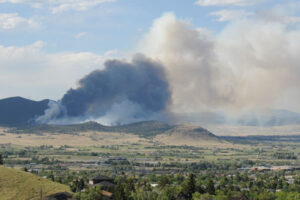
Windblown fire races through grazed grasslands near Helena, Montana. Photo George Wuerthner
In an overview of various fuel reductions, the researchers (Reinhard et al. 2008) concluded that: “Extreme environmental conditions …overwhelmed most fuel treatment effects. . . This included almost all treatment methods including prescribed burning and thinning. . .. Suppression efforts had little benefit from fuel modifications.”
Although they primarily examined forest management options, the same necessary conclusions apply to reducing fuels on rangelands (Williamson, Matt. A. et al., 2019)
SEVERE GRAZING AND COLLATERAL DAMAGE
Severe grazing can reduce fuels that would allow fires to spread. Still, grazing to this level creates a lot of collateral damage, including soil compaction, which reduces water infiltration (Warren, S.D. et al., 1986, Belsky et al. 1999), social displacement of native herbivores like elk and deer (Clegg 2014, Frisina 1992), water pollution (Carter, 2002), destruction of riparian areas (the green line of vegetation influenced by water) (Kauffman 2004), consumption of plants needed by other wildlife like forbs consumed by sage grouse (Doherty et al. 2014), and reduction of hiding cover for wildlife, and many other impacts (Fleischner 1994, Freilich et al., 2003).
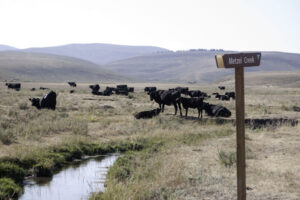
Collateral damage from livestock grazing includes cattle damage to riparian zones (the green vegetation area near water). Photo George Wuerthner.
It is important to note that much of the grassland/shrub ecosystems of the western United States west of the Great Plains evolved in the absence of large herds of grazing herbivores like bison (Mack and Thompson 1982), thus are vulnerable to heavy grazing pressure.
Alternatively, and far more critical these days, livestock grazing is one factor in the spread of cheatgrass, an annual exotic that is extremely flammable (Belsky, A.J. and J. L. Gelbard, 2000). Merriam et al. (2006) found that nonnative plant abundance was considerably higher on fuel breaks than in adjacent wildland areas, especially when the heavy ground disturbance was involved, providing a potential vector for weed invasion
Therefore, cheatgrass has increased fire frequency in sagebrush ecosystems, causing complete type conversion of sagebrush steppe in many areas (Reisner Michael D. et al. 2013).
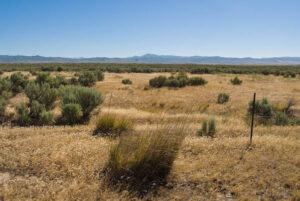 Cheatgrass surrounds a relict perennial native grass. Photo George Wuerthner.
Cheatgrass surrounds a relict perennial native grass. Photo George Wuerthner.
The factors that favor cheatgrass spread, including livestock grazing. Selective grazing of preferred perennial grasses reduces their competitive abilities, permitting cheatgrass colonization (Maestas et al. 2019)
Besides, biological soil crusts (BSC) found in the interspaces between bunchgrasses inhibits cheatgrass establishment. Cattle trample these BSC (Root, Miller, and Rosentreter. 2019).
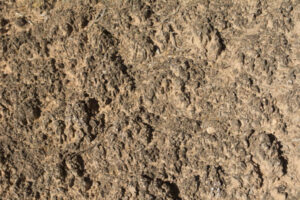
Biological crust covers the surface of soil. Cattle trampling crusts creates habitat for cheatgrass establishment. Photo George Wuerthner.
Maintaining healthy stands of perennial grasses has been shown to inhibit cheatgrass spread (Strand et al., 2017).
Another study that looked at fuel breaks created by targeted grazing and other measures like bulldozing native vegetation cautioned that the “cure might be worse than the disease” since the destruction of soil biological crusts and loss of native grasses that occur with targeted grazing, bulldozing. Other fuel reductions create a disturbance habitat that favors the spread of cheatgrass.
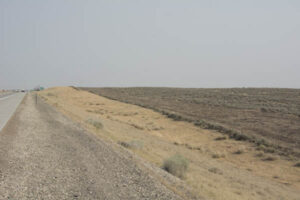
Fuel break on BLM land creates the ideal habitat for cheatgrass establishment. Photo George Wuerthner.
The authors cautioned: “these projects could also add thousands of kilometers of new fuel breaks to the region over the next decade or two, directly altering hundreds of thousands of hectares through habitat conversion, and indirectly affecting sagebrush plant and animal communities through the creation of new edge effects and habitat fragmentation” (Shinneman et al. 2018).
Furthermore, the probability that any area “treated” by targeted grazing and other fuel reductions will encounter a blaze when fuel removal is effective is extremely small (Rhodes and Baker 2008). Thus, targeted grazing and further fuel reductions, which have their own set of impacts, occur now, potentially reducing a fire that may or may not come in the future.
SUMMARY
Using livestock grazing to preclude large wildfires is an ineffective means of coping with blazes. Livestock grazing has little influence on large-scale blazes, primarily driven by extreme climate/weather events. The probability that a large fire will encounter a recently grazed area is small, but livestock grazing’s ecological impacts are enormous and assured. The best way to reduce wildlife’s threat is to fire-safe the home and ultimately reduce global climate warming, driving many of the more enormous blazes experienced in the West.
REFERENCES
Belsky, A.J., A. Matzke, and S. Uselman. “Survey of Livestock Influences on Stream and Riparian Ecosystems in the Western United States.” 1999. Journal of Soil and Water Conservation, Vol. 54. Online. Aug 25, 2003.
Belsky, A.J., and J. L. Gelbard, 2000. Livestock Grazing and Weed Invasions in the Arid West, Oregon Natural Desert Association, Bend, Ore, USA, 2000.
Bruegger, Retta A. et al. (2016). Targeted Grazing in Southern Arizona: Using Cattle to Reduce Fine Fuel Loads Rangeland Ecology & Management Volume 69, Issue 1, January 2016, Pages 43-51
Carter, John. 2002. Stink Water: Declining Water Quality Due to Livestock Production. In Welfare Ranching: The Subsidized Destruction of the American West Edited by George Wuerthner and Mollie Matteson.
Clegg, Kenneth. 1994. Density and Feeding Habits of Elk and Deer in Relation to Livestock Disturbance Master of Science Utah State University.
Diamond, Joel, Christopher A. Call, and Nora Devoe. 2009. Effects of targeted cattle grazing on fire behavior of cheatgrass-dominated rangeland in the northern Great Basin, USA International Journal of Wildland Fire 2009, 18, 944–950
Doherty, Kevin, David E. Naugle, Jason D. Tack, Brett L. Walker, Jon M. Graham, and Jeffrey Beck. 2014. Linking conservation actions to demography: grass height explains variation in greater sage-grouse nest survival. Wildlife Biology, 20(6):320-325. 2014
Freilich et al., 2003. Ecological Effects of Ranching: A Six-Point Critique. August 2003 / Vol. 53 No. 8 • BioScience 759
Fleischner, Thomas. 1994. Ecological Costs of Livestock Grazing on Western North America. Conservation Biology 8, no. 3629-644.
Frisina, M.R., 1992. Elk habitat use within a rest rotation grazing system. Rangelands 14(2) 93—96.
Kauffman, B., Andrea Thorpe, and Jack Brookshire. (2004) LIVESTOCK EXCLUSION AND BELOWGROUND ECOSYSTEM RESPONSES IN RIPARIAN MEADOWS OF EASTERN OREGON Ecological Applications, 14(6), 2004, pp. 1671–1679 q 2004 by the Ecological Society of America
Mack Richard N. and John N. Thompson. 1982. Evolution of the Steppe with few large, hoofed mammals The American Naturalist. Vol 19. No. 6.
Maestas, Jeremy, Mike Pellant, Lance Okeson, Derek Tilley, Doug Havlina, Trisha Cracroft, Brendan Brazee, Mark Williams, and Derek Messmer (2019) Technical Note: Fuel Breaks to Reduce Large Wildfire Impacts in Sagebrush Ecosystems. Boise, Idaho..
Merriam, K.E, Jon Keeley, and Jan l. Beyers. Fuel Breaks Affect Nonnative Species Abundance in California Plant Communities. Ecological Applications, 16(2), 2006, pp. 515–527
Reinhardt etc. (2008) Objectives and considerations for wildland fuel treatment in forested ecosystems of the interior western United States.
Reisner, Michael D. et al., 2013. Conditions are favouring Bromus tectorum dominance of endangered sagebrush steppe ecosystems. Journal of Applied Ecology 2013
Root, Heather et al., 2019. Grazing disturbance promotes exotic annual grasses by degrading soil biocrust communities. Ecological Applications, 0(0), 2019, e02016
Shinneman, Douglas J., Cameron L. Aldridge, Peter S. Coates, Matthew J. Germino, David S. Pilliod, and Nicole M. Vaillant. 2018. A Conservation Paradox in the Great Basin—Altering Sagebrush Landscapes with Fuel Breaks to Reduce Habitat Loss from Wildfire. Open-File Report 2018-1034 Frontiers in Ecology and the Environment https://doi.org/10.1002/fee.2045
Strand, E. et al., 2017. Do perennial bunchgrasses competitively exclude Bromus tectorum in post-fire rehabilitation across spatial scales? Fire Science JFSP PROJECT ID: 15-2-01-22
Warren, S.D. et al., 1986. The Influence of Livestock Trampling under Intensive Rotation Grazing on Soil Hydrologic Characteristics. JOURNAL OF RANGE MANAGEMENT 39(6). November 1966
Williamson, Matt. A. et al., 2019. Fire, livestock grazing, topography, and precipitation affect occurrence and prevalence of cheatgrass (Bromus tectorum) in the central Great Basin, USA Biol Invasions https://doi.org/10.1007/s10530-019-02120-8(0123456789().,-vols() 0123458697().,-volV)